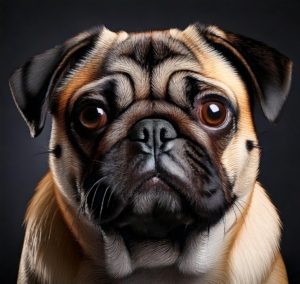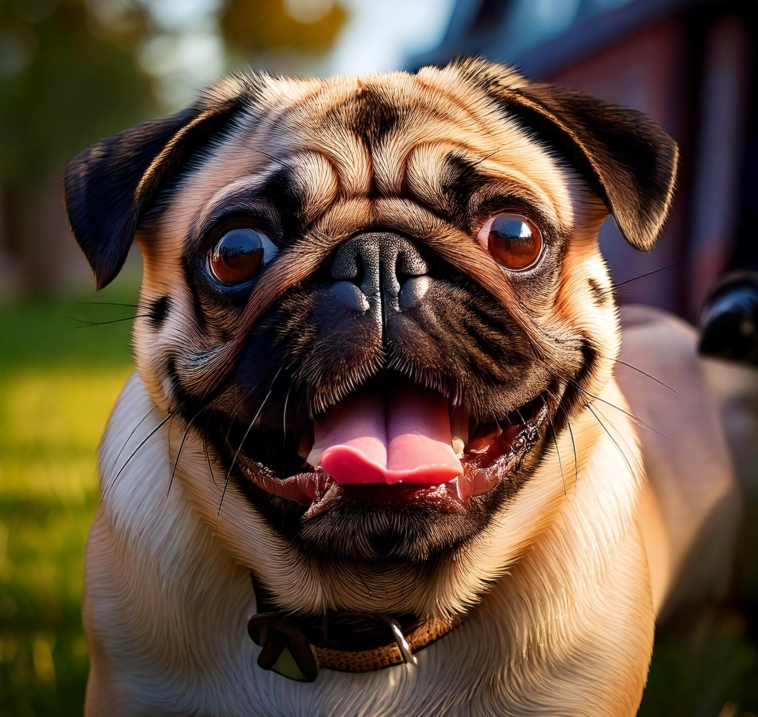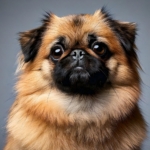Last updated on October 29th, 2024
Here’s an overview:
Historical Background and Breed Origins
Socializing and Interacting with Humans
Pug Behavior with Other Pets and Animals
Techniques to Avoid Pug Behavior Problems
Health Problems and Its Effect on Their Behavior
Age-related Alteration in Pug temperament
Activities and Games Suitable for pug’s nature
Potential Behavior Concerns and Solutions in Pug
The Importance of Routine and Pug temperament
Making Environments That Pugs Would Love
Final thoughts: love your pug & Pug temperament
Pug Temperament: Introduction
Pugs are funny and loving dogs that have a playful side to them which many families appreciate. Generally, they’re friendly and get along well with children and other pets. Pugs have a playful character and desperately seek companionship. These dogs tend to be pretty loyal and love attention. Even though pugs are quite small, they are brave and love to explore. However, they do tend to be quite stubborn. Nevertheless, their intelligence shines through and they are cheerful companions.
- Loving
- Sociable
- Faithful
- Active
- Inquisitive
Historical Background and Breed Origins
The Pug’s fairytale like looks and personality has a very long and interesting history that began in China dating back to the Han Dynasty (206 B.C.-220 A.D.). The pug was breed as a pet dog for the Chinese kings and queens.
- Early Chinese Royalty: Pugs were cherished and adored by the emperors of China and lived a life of pleasure along with their owners.
- Journey to Europe: Pugs made their first appearance in Europe in the 16th century brought back by sailors and traders.
- European Aristocracy: The royalty in Europe welcomed Pugs with open arms particularly the Dutch and the French.
They have large round eyes and push in faces. They’re distinctive in their appearance as a breed, but they also have the same characteristics in their temperament. They’ve been bred to be useful companions and little bossy brats to entertain people; their behavior tells us that much.
Their cuddly round physique offers a group of bad traits definitely less dangerous; therefore, if you want to own one as a pet be sure to train them well so they’re not aggressive towards everybody. Make sure to get them from a trustworthy breeder as well because they’ll have a longer lifespan.
Socializing and Interacting with Humans
Pugs are not just chatty but they absolutely love to get mixed with their owners, so much so that they wouldn’t stray when given a chance. Infact, they can get close to their family due to their loving and friendly personality. They can also distinguish human emotions perfectly to a point where they know how to respond properly.
- Companionship: Despite getting cuddles all the time, Pugs do tend to feel lonely and everybody knows that they love their owners, so it’s pretty common for them to seek out their owners for affection.
- Playfulness: Even though pugs are small, it does not stop them from being the life of the party and playing with their favorite toys.
- Adaptability: Homely routines are not an issue for them and they will easily adjust in a new household environment.
- Attention: Considering how pugs are affectionate dogs, they do tend to feel anxious if they don’t get positive attention or respond well when they aren’t neglected.
- Training: Pugs can be trained in the best way with praise and rewards.
Pug Behavior with Other Pets and Animals
Pugs can be described as the most social animals as they display a friendly behavior towards the pets they are supervised with. Not even mentioning how they enjoy being in socializing situations. Some of the ways one can best cater to them are:
- Socializing: Parties and socialization help them in a way that if a kid comes, they will be overwhelmed but do not panic.
- Temperament: Infact, they have a gentle temperament, and a sweet personality without aggression.
- Compatibility: They do tend to get along with other species of animals such as cats, dogs,or rabbits so long as they have supervision when being introduced.
- Traning: They are more than friendly when they meet have controllable aggression.
- Observation: It’s best to supervise/spot their early introductions and meetings so that there are no chances of anxiety.
- Playfulness. Due to their playful character, they tend to have a good rapport with other animals.

Techniques to Avoid Pug Behavior Problems
- Appeasement. For each performance of the desired behavior such as sit, come or fetch, give a Pug some treats, praise or toys. In this way, the chances of the Pug repeating those behaviors are increased.
- Regular Terms. Stick to the same terms and signs when issuing instructions. Regularity assists the Pug in deciphering the order as well as complying with it.
- Infrequent Sessions. Limit each training session to around 10 to 15minutes, not more than that. In case the training goes on for a longer period, pugs can lose sight of the purpose.
- Pet Breeds. Let the Pug meet new acquaintances, ladies, and pets to lower the level of anxiety and aggression.
- Useful Training. Start early with leash training to stop pulling and to minimize the potential of bad walks.
- Hopeful Content. Use the slow and steady approach while fought back with gentle an aggressive spirit. Though it might take some time, Pugs will eventually get accustomed to the change.
Health Problems and Its Effect on Their Behavior
There are various health issues that Pugs suffer from which can alter their behavior as well as their temperament.
Health problems experienced most often
- Airway Collapse. Breathing difficulties leads someone to develop a lesser physical activity and a shorter temper.
- Excess Weight. Too much of anything qualifies for lack of energy and more stress.
- Dysplastic Hips. Medically if one suffers from painful hip joints, then irritability peaks or aggression can be seen.
- Eye Issues: Some eye problems such as cornel ulcer can cause some degree of worry and uncomfortable feelings.
Other Aspects of the behavior
- Tension and worry: Often as a result of health issues one tends to worry and feel stressed.
- Less Active: Illness can cause pugs to be not as active in playful activities.
- In Different Moods: Chronic pain can make one behave in different ways.
Age-related Alteration in Pug temperament
As pugs grow, their temperament which is related to age does change.
Puppy (0-1 year)
- Sense of Inquisitiveness: Has a very inquisitive as well as an energetic personality.
- Sociability: It is friendly and likes animals and people.
- Learning and Training: They learn quickly forget easily because they are very fickle-minded.
Adult (1-7 years of age)
- Moderation: Their personality begin to become balanced and less unpredictable.
- Playfulness: Even though playful not as hyperactive.
- Protectiveness: They begin to feel more conscious of the environment and their people.
Senior (7+ years)
- Fussiness Level: They tend to be more relaxed in dealing with things.
- Lunacy: Their general rate of activity goes down.
- Jealousy: They begin to be more affectionate and clingy.
Activities and Games Suitable for pug’s nature
Pugs are funny and comical dogs, therefore, they love to get involved in brain and body activities.
- Engagement in Short Walks: Activities in a short walk can be of value to pugs as it is a short time of brachial activity.
- Enjoyment and Use of Stimulating Toys: Toy puzzles and toys that serve for food dispersal allow for better mental stimulation.
- Social Interactions: Pugs love to interact with people and love to play with other dogs.
- Training Sessions: It deepens the relationship with the owners and works great to keep these dog’s minds engaged through positive reinforcement training.
- Indoor Fetch: They have indoor spaces which are safe and secure enabling them to play with modified fetch games.
These activities ensure a balanced, enriched lifestyle for the pugs.
Potential Behavior Concerns and Solutions in Pug
Many love pugs and their characters, but they are known to have a few behavior problems. It is vital to talk about these behavior problems as soon as possible.
- Separation Anxiety: Pugs are naturally territorial and attached to their owners, and thus show anxiety when left alone. So owners may seek help through gradual desensitization, toys for interaction and constantly changing their routines.
- Barking: This might be because of lack of activity or anxiety. Teaching proper behavior during training sessions and exercise decrease their barking.
- Obstinacy Issues: Because Pugs can be quite stubborn as a breed, patience and methods with positive reinforcement will ensure your pug obeys you.
- Obesity: Being food lovers, pugs can become over weight, providing them with regular exercise and balanced diet helps in preventing obesity.
The Importance of Routine and Pug temperament
Having set routines and stability is essential for a pug’s environment to thrive. Structured meal schedules, exercise times, or set rituals throughout the day affect the well-being of the pug positively.
- Meal Consistency: Providing food at a particular time can be easy to follow by both the owners and the pugs and it helps them when it’s time to eat.
- Exercise Routine: Where dogs can play, run and go for walks definitely helps pugs to distress and also reduces chances of them gaining weight.
- Set up Consistency: An environment that is stable and repetitive not only gives security to a pug but also helps in reducing anxiety and aggressive behavior.
Rest following a set routine and living in a stable environment is the best for pugs as it increases their overall quality of life.
Making Environments That Pugs Would Love
Pugs are only a happy ball of fur when they get exercise, love as well as mental stimulation so follow these rules in order to set up a balanced environment and become a pug order.
- Give Regular Cards
- Go on two mini strolls during the day.
- Give pugs their favorite toys in order to play.
- Perfect Diet
- Make them eat high quality dog food.
- Set the amount of food pugs can intake to avoid obesity.
- Interact With Dogs
- Make other dog owners meet with you so your pug can enjoy.
- Have kids around them for an entire day.
- Exercise Their Brain
- Puzzle toys and rooms are a great way to keep pugs mentally healthy and excited.
- Showing pugs how to do new tricks everyday is an exercise for their big brains.
- Ensure Relax Spaces
- Provide a bed away from people in a quiet place.
- Don’t make their room to hot or cold.
Final thoughts: love your pug & Pug temperament
Knowing a pug temperament can go a long way in building enduring marital bonds with love. The combination of being affectionate, playful and intelligent are ideal characteristics of a pet.
- Affectionate: Pugs are loving and hence can be warm.
- Playful: They are playful but does not get carried away often.
- Intelligent: They are bright and learn quickly but need to be trained well.
Fundamentally, having enough patience and training is the key. With good care, the relationship with pugs get stronger such that they become very loving members of the family.




